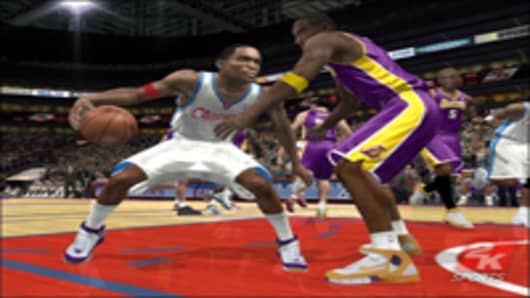Video Games Vs. the Real Thing
I'll never forget what NBA commissioner David Stern said in June 2005 in a New York Times article. The piece talked about how some young kids were more interested in playing NBA video games than watching the real thing. "I was on a panel recently where someone asked me what my worst fear was," Stern said at the time. "It was that as video games got so graphically close to perfection, and you could create your own players -- their hairdos, their shoes -- that there might be a battle between seeing games in person or on television and seeing it play out on a video game."
The author noted that Stern said he was speaking "mildly tongue and cheek," but I didn't believe it for a second. David Stern knew exactly what he was talking about. And it appears, almost two years later, that we're very close to that reality – the day when more kids will be playing with their own NBA players on video games than watching the game.
Video game consoles in U.S. television households expanded by an incredible 18.5 percent since the fourth quarter of 2004, according to a new report released by Nielsel Wireless and Interactive Strategies. And in the fourth quarter of last year, there were 45.7 million homes with video game consoles, representing 41.1 percent of all TV households, compared to 43 percent of homes in 2005 and 35.2 percent of homes in 2004.
What this all means is that video games are finally getting a chance to compete against the real product. The New York Times article specifically talked about losing the young audience to television. We'll be able to tell later this year, when Nielsen releases its GamePlay Metrics data, for the first time whether sports video games are being played by more young people than are watching the very games they are mimicking.
Here is some data that Nielsen did make available, which leads me to believe it could be a close race: Eighty percent of 12-17-year-olds in the U.S. population played on a video console in the final three months of last year.
In the licensing game, the fake thing has already surpassed the real thing in some areas of sporting life. An article in the Idaho Statesman talked about former Boise State quarterback Jared Zabransky being the new cover boy for Electronic Arts' NCAA Football 2008 game. Brad Larrondo, the Broncos' senior assistant athletic director for promotions and marketing, admitted that Boise State actually got paid more money in royalties by Electronic Arts last year ($78,551) for being part of the game than the folks at Nike pay them to put their swoosh all over the place ($47,500).
The biggest companies in the world are also realizing the potential that video game play among the young demographic could rival TV watching. When Microsoft bought video game advertiser Massive last year, Microsoft's Joanne Bradford said exactly that. Said Bradford: "Advertisers are having a tough time connecting with the elusive 18-to-34-year-old male demographic because this group continues to spend less time watching TV and more time playing video games." Google then made their move this year by acquiring Adscape media, which similarly places advertising in games.
Red Bull & Puma
The folks at Red Bull are in the news again today. Puma announced that they have agreed to a multi-year deal with Red Bull's drivers in F1 and NASCAR drivers as well as its air race pilots to be the team's supplier of suits, shoes apparel and accessories. Part of the deal will include a lifestyle-inspired replica collection of Red Bull product.
I've always been intrigued by shoe and apparel brands in NASCAR. For years, they have looked – unsuccessfully for the most part – to cash in on the rising popularity of the sport. A few years ago, I was told Reebok looked at sponsoring a car, but in the end felt it didn't make sense because you'd never really see their driver "using their product" like you would a basketball player playing in the company's shoes for the entire game. But, in recent years, the wheels have certainly started to turn. Puma launched a big ad campaign last year with NASCAR driver Kasey Kahne and Nike just formed an alliance with Joe Gibbs racing to make low-end logoed shoes featuring its race teams. But not unless something happens and these weird looking racing shoes catch on on the fashion fringe, this still seems to be a category where the major players in the shoe business are always going to be behind.
Questions? Comments? SportsBiz@cnbc.com



